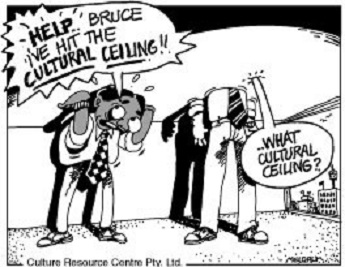Blog Culture@Work
Welcome! My name is Joost Thissen and here I like to share cultural columns and insights for those of us who are interested in culturally diverse and global workplaces.


Welcome! My name is Joost Thissen and here I like to share cultural columns and insights for those of us who are interested in culturally diverse and global workplaces.


cultural column  Email This Post
Email This Post
The term ‘bamboo ceiling’ was first coined in 2005 by Jane Hyun who defined it as a combination of individual, cultural, and organisational factors that impede Asian Americans’ career progress inside organisations. Australian Race Discrimination Commissioner Chin Tan used it in 2019 as the barriers that keep those of Asian background away from the highest levels of leadership in business and the law. In our L&D practice we call it the ‘Cultural Ceiling‘ as to include a wide range of culturally diverse staff that is impacted.
Australian organisations are paying more and more attention to this ‘Bamboo Ceiling’ phenomenon: their culturally diverse staff were leaving the organisation in higher than average numbers. It therefore makes sense to consider why some organisations have a higher than average staff turnover among their culturally diverse professionals. Let’s analyse what happened and what we could learn from it in order to change this practice and become an effective and inclusive multicultural workplace (and keeping cost of recruiting, training and developing down and the good company name and imago ‘up’),
The HR Director of an Australian Financial organisation asked us to train their culturally diverse professionals to work and to progress in the Australian organisation. She recognised that the turnover among the group of culturally diverse professionals seemed rather high compared to other professionals, and barely ever made the level of manager.
We set up a number of focus group meetings for a. culturally diverse staff and for b. representatives of the management team. We wanted to get a really good grasp of what both staff and management understood about the challenges and opportunities of culturally diverse staff, and what they want to get out of the proposed staff training.
After the staff focus group sessions were completed, the next step in our process was to debrief the management team about our findings. The management focus group session was attended by the majority of the management team: predominantly Anglo-Australian middle aged males and one Australian middle-aged female with Italian heritage. During the meeting it became clear that challenges identified during the staff focus group sessions, e.g. intercultural communication styles, culturally preferred management styles, developing relationships and trust, and culturally diverse feedback techniques etc. were new to them.
We shared a story about two of their high potential culturally diverse professionals (one Chinese and one Indian staff) who confessed to us (being the focus group facilitators and both European) that they felt that the Australians were pretty poor managers: ‘our manager often ask us what we think about certain issues rather than that they tell us what to do’. The Australian manager was therefore judged by them as indecisive, and regarded clueless about the technical aspects of the job.
A leadership style that seems to work perfectly fine in the one culture, can quite easily be regarded as ineffective in another culture…
There were ‘penny dropping’ moments during the session as the management team began to realise why some awkward staff situations in the past were actually due to cultural misunderstandings and ignorance on their part.
One of the managers confessed that he believed that it was ‘easier’ to appoint staff who are ‘alike’ in their looks and dress, alike in how they communicate, their work style, and their hobbies (What else do you talk about after the weekend?). The managers found out that not only was the turn-over among their culturally diverse staff much higher than they realised, they also started to question if it was actually them and their management approach that caused the negative impact and thus staff leaving the organisation. There was an interesting discussion about how some managers used to be of the opinion that culturally diverse staff needed training, and now realised that they themselves needed to develop the cultural competence of managing culturally diverse staff.
After they participated in a cultural competence development training workshop, the majority of the managers acknowledged the importance of having the skills and competence to better manage culturally diverse staff. Resulting in to better motivate, develop, provide feedback and rewards and, therefore retain good staff. That same management team is now much better prepared and more committed to manage culturally diverse professionals and coaching them for possible managerial roles to break through the perceived cultural or ‘bamboo’ ceiling.
We were asked by the HR department for another multicultural organisation to help investigate why the cultural diversity in the organisation was not reflected at the management and directors level.
The HR manager told us that the organisation had invested in developing an on-line staff communication system, which outlined career options, job vacancies, learning & development initiatives, and opportunities for joining a talent pool to prepare for managerial positions. HR was surprised and disappointed by the lack of interest shown by their culturally diverse and potential ‘management material’ in this initiative. During a range of focus groups among different teams, locations and levels, we found a number of reasons to explain the lack of interest. The most striking reason is being explained below.
In the Australian culture in general and in this organisation in particular, staff are pretty much expected to take care of their own career: it is up to you to express what you want, you are directed to the available resources by the organisation (i.e. the communication via the intranet) and you can consult your manager about the best process – but you need to take the initiative. However, we heard from culturally diverse staff that this organisation employs believe that it is not up to them to decide what their next career step is. They expect their manager to take the initiative. Not surprising that mostly representatives of the (egalitarian) Anglo-cultures worked their way up the management ladder…while the predominantly (hierarchical) Asian cultures waited patiently for their managers to promote them. When so many of the culturally diverse staff felt over-looked, they often left the organisation resulting in high staff turnover and a lack of cultural diversity at senior levels.
In the first scenario, the management team did not realise that they themselves were a big part in creating the ceiling and unconsciously kept the ‘ceiling’ in place.
In the second scenario, even though the management team actually wanted to encourage culturally diverse staff for managerial positions, they realised that this process needs to be guided by culturally appropriate procedures and practices to remove the ‘ceiling’ and avoid the negative impact of high staff turnover…
Further Reading:
Tanveer Ahmed 2019, The bamboo ceiling and the meaning of Meritocracy, in Australian Financial Review
_________________________________________
Joost Thissen, Partner & Interculturalist
joost@cultureresourcecentre.com.au
cultural column  Email This Post
Email This Post